Biology Homework: Human Life Processes, Cell Structure, and Digestion
VerifiedAdded on 2023/01/19
|6
|1175
|37
Homework Assignment
AI Summary
This biology assignment explores the fundamental life processes characteristic of living organisms, including movement, reproduction, and nutrition. It delves into the structure and function of human cells, detailing the roles of various organelles such as the cytoplasm, endoplasmic reticulum, Golgi apparatus, and mitochondria. The assignment then examines the human circulatory system, highlighting its key features, including the heart and blood components, such as red and white blood cells, and their respective functions. Finally, it provides an overview of the human digestive system, explaining the breakdown and absorption of proteins, fats, and carbohydrates, and the role of enzymes and other digestive organs in these processes. The assignment is well-referenced, citing relevant literature to support the information presented.
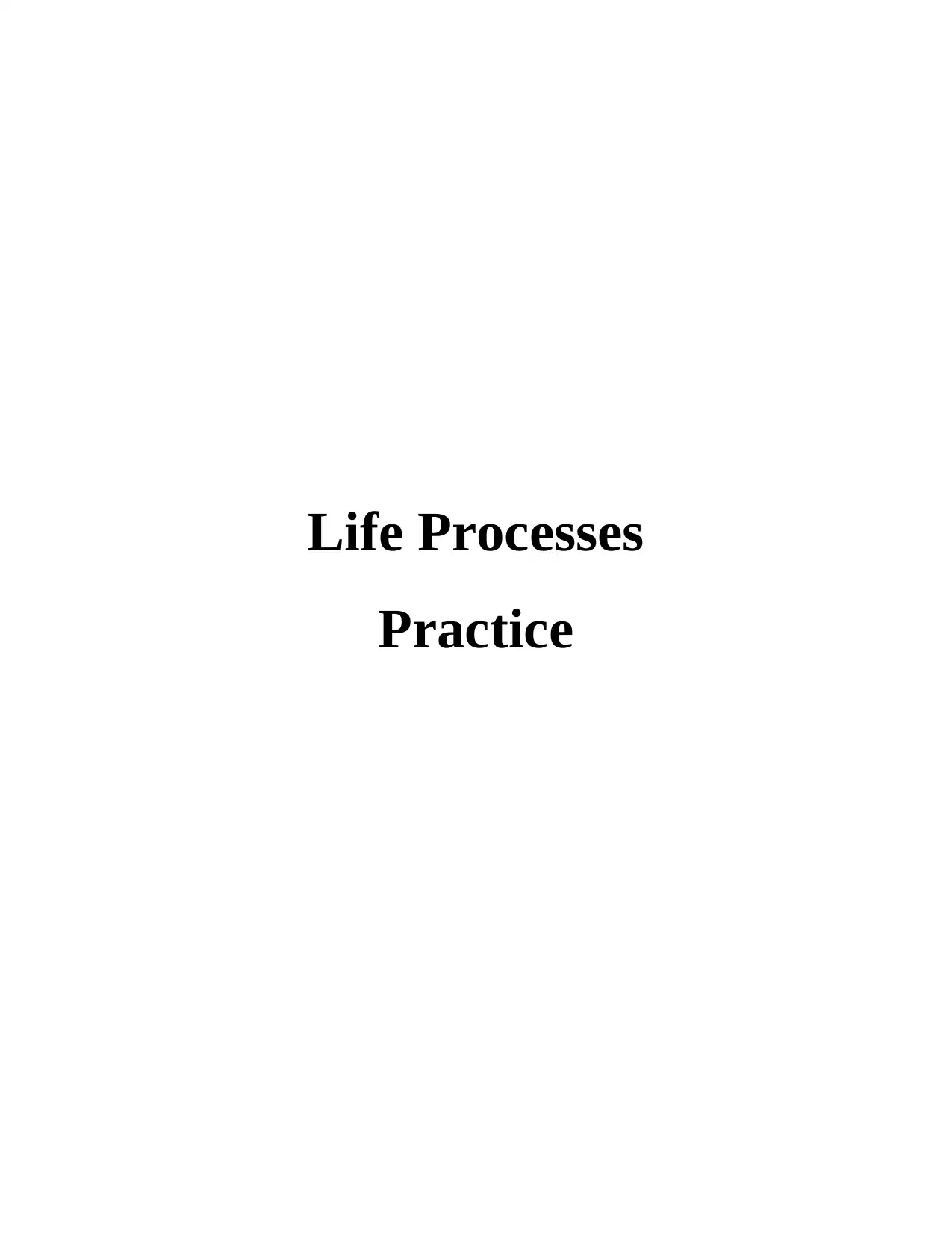
Life Processes
Practice
Practice
Paraphrase This Document
Need a fresh take? Get an instant paraphrase of this document with our AI Paraphraser
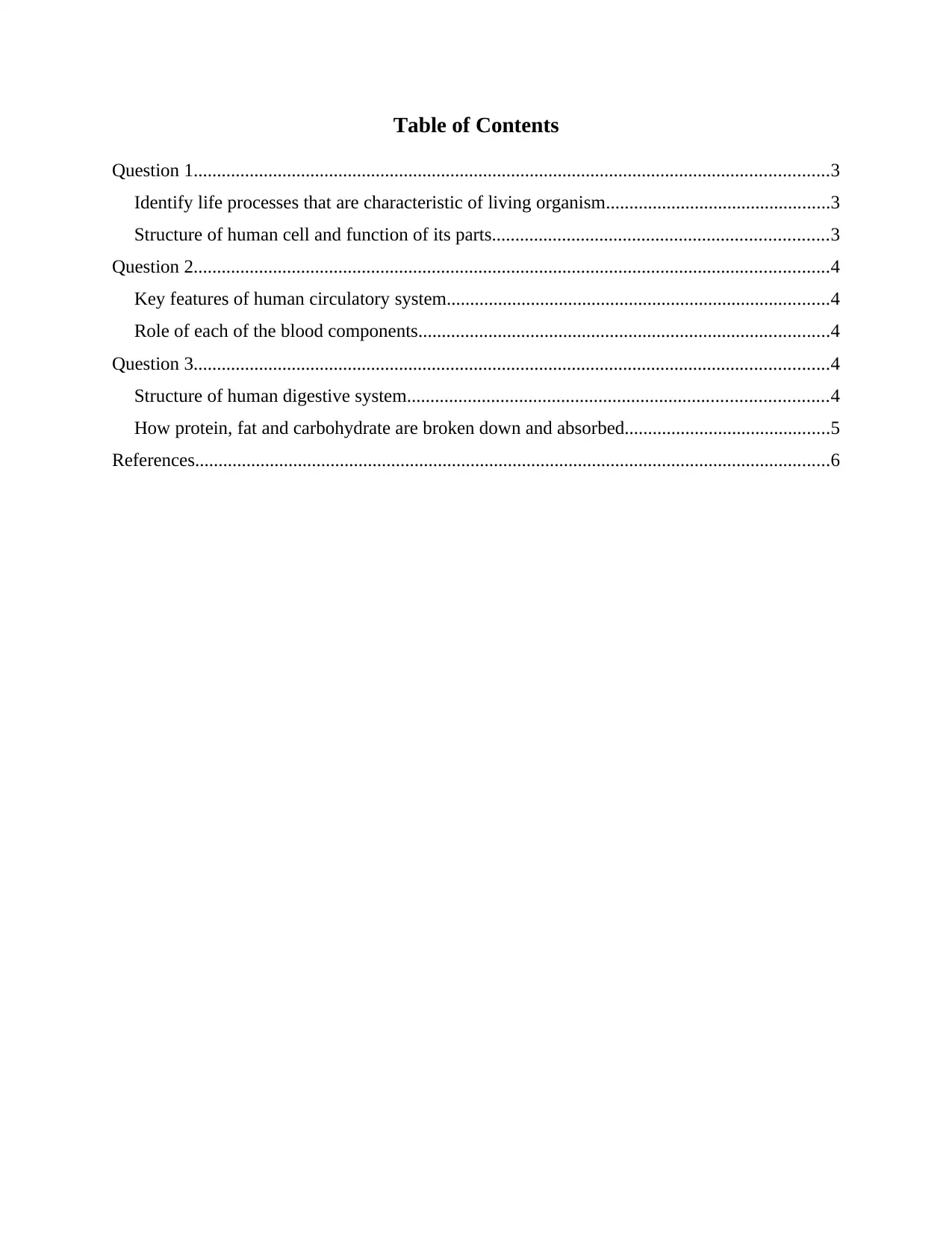
Table of Contents
Question 1........................................................................................................................................3
Identify life processes that are characteristic of living organism................................................3
Structure of human cell and function of its parts........................................................................3
Question 2........................................................................................................................................4
Key features of human circulatory system..................................................................................4
Role of each of the blood components........................................................................................4
Question 3........................................................................................................................................4
Structure of human digestive system..........................................................................................4
How protein, fat and carbohydrate are broken down and absorbed............................................5
References........................................................................................................................................6
Question 1........................................................................................................................................3
Identify life processes that are characteristic of living organism................................................3
Structure of human cell and function of its parts........................................................................3
Question 2........................................................................................................................................4
Key features of human circulatory system..................................................................................4
Role of each of the blood components........................................................................................4
Question 3........................................................................................................................................4
Structure of human digestive system..........................................................................................4
How protein, fat and carbohydrate are broken down and absorbed............................................5
References........................................................................................................................................6
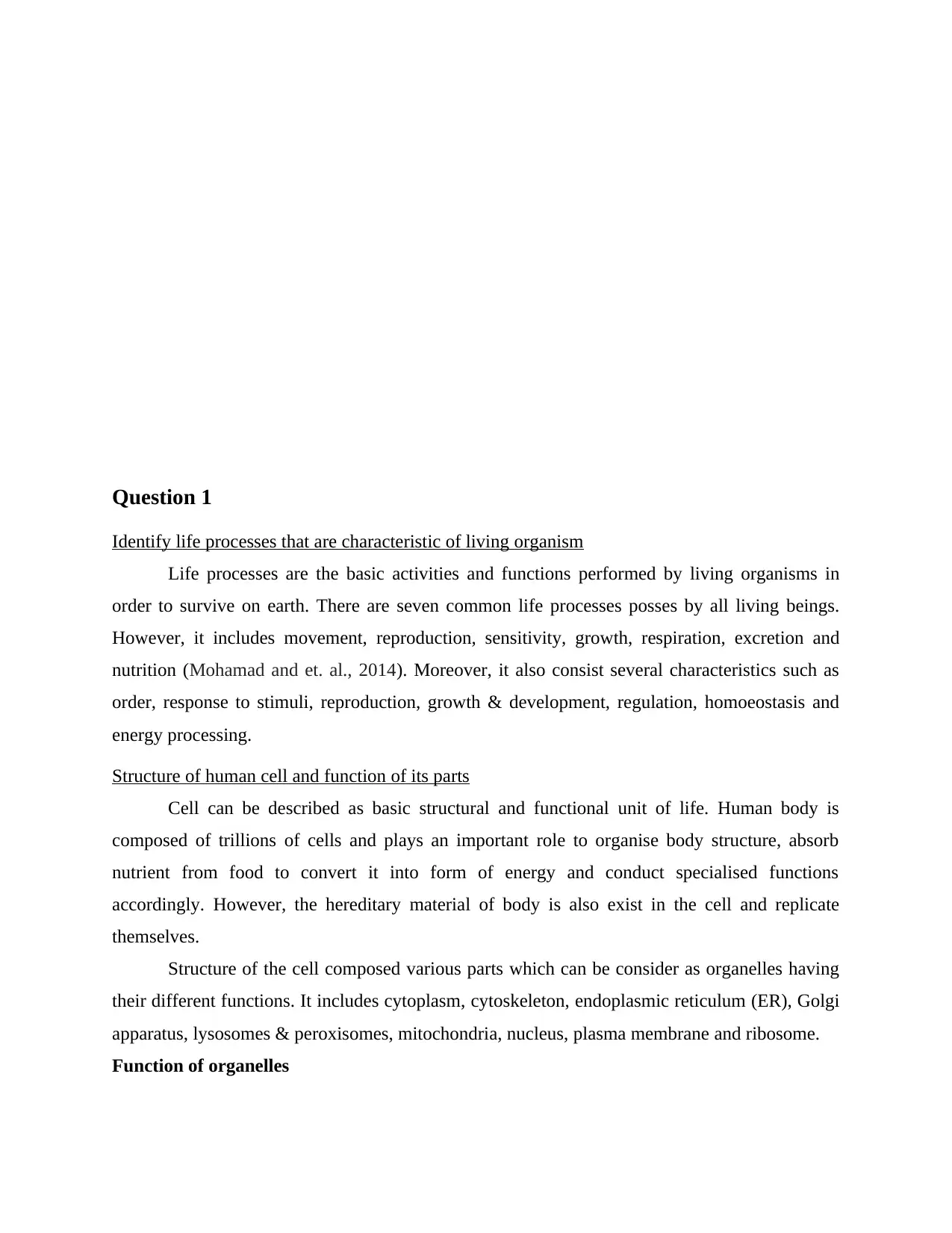
Question 1
Identify life processes that are characteristic of living organism
Life processes are the basic activities and functions performed by living organisms in
order to survive on earth. There are seven common life processes posses by all living beings.
However, it includes movement, reproduction, sensitivity, growth, respiration, excretion and
nutrition (Mohamad and et. al., 2014). Moreover, it also consist several characteristics such as
order, response to stimuli, reproduction, growth & development, regulation, homoeostasis and
energy processing.
Structure of human cell and function of its parts
Cell can be described as basic structural and functional unit of life. Human body is
composed of trillions of cells and plays an important role to organise body structure, absorb
nutrient from food to convert it into form of energy and conduct specialised functions
accordingly. However, the hereditary material of body is also exist in the cell and replicate
themselves.
Structure of the cell composed various parts which can be consider as organelles having
their different functions. It includes cytoplasm, cytoskeleton, endoplasmic reticulum (ER), Golgi
apparatus, lysosomes & peroxisomes, mitochondria, nucleus, plasma membrane and ribosome.
Function of organelles
Identify life processes that are characteristic of living organism
Life processes are the basic activities and functions performed by living organisms in
order to survive on earth. There are seven common life processes posses by all living beings.
However, it includes movement, reproduction, sensitivity, growth, respiration, excretion and
nutrition (Mohamad and et. al., 2014). Moreover, it also consist several characteristics such as
order, response to stimuli, reproduction, growth & development, regulation, homoeostasis and
energy processing.
Structure of human cell and function of its parts
Cell can be described as basic structural and functional unit of life. Human body is
composed of trillions of cells and plays an important role to organise body structure, absorb
nutrient from food to convert it into form of energy and conduct specialised functions
accordingly. However, the hereditary material of body is also exist in the cell and replicate
themselves.
Structure of the cell composed various parts which can be consider as organelles having
their different functions. It includes cytoplasm, cytoskeleton, endoplasmic reticulum (ER), Golgi
apparatus, lysosomes & peroxisomes, mitochondria, nucleus, plasma membrane and ribosome.
Function of organelles
⊘ This is a preview!⊘
Do you want full access?
Subscribe today to unlock all pages.

Trusted by 1+ million students worldwide
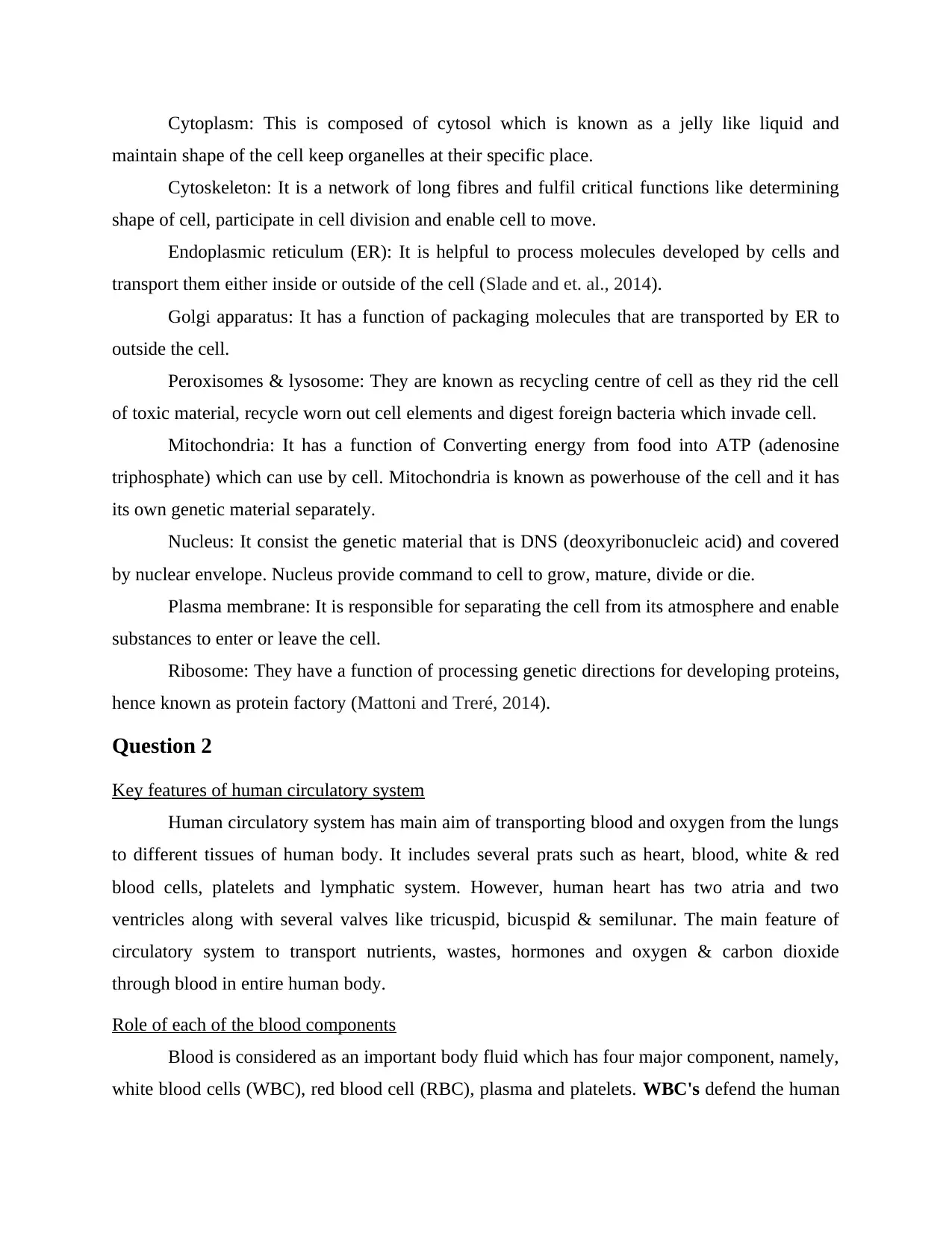
Cytoplasm: This is composed of cytosol which is known as a jelly like liquid and
maintain shape of the cell keep organelles at their specific place.
Cytoskeleton: It is a network of long fibres and fulfil critical functions like determining
shape of cell, participate in cell division and enable cell to move.
Endoplasmic reticulum (ER): It is helpful to process molecules developed by cells and
transport them either inside or outside of the cell (Slade and et. al., 2014).
Golgi apparatus: It has a function of packaging molecules that are transported by ER to
outside the cell.
Peroxisomes & lysosome: They are known as recycling centre of cell as they rid the cell
of toxic material, recycle worn out cell elements and digest foreign bacteria which invade cell.
Mitochondria: It has a function of Converting energy from food into ATP (adenosine
triphosphate) which can use by cell. Mitochondria is known as powerhouse of the cell and it has
its own genetic material separately.
Nucleus: It consist the genetic material that is DNS (deoxyribonucleic acid) and covered
by nuclear envelope. Nucleus provide command to cell to grow, mature, divide or die.
Plasma membrane: It is responsible for separating the cell from its atmosphere and enable
substances to enter or leave the cell.
Ribosome: They have a function of processing genetic directions for developing proteins,
hence known as protein factory (Mattoni and Treré, 2014).
Question 2
Key features of human circulatory system
Human circulatory system has main aim of transporting blood and oxygen from the lungs
to different tissues of human body. It includes several prats such as heart, blood, white & red
blood cells, platelets and lymphatic system. However, human heart has two atria and two
ventricles along with several valves like tricuspid, bicuspid & semilunar. The main feature of
circulatory system to transport nutrients, wastes, hormones and oxygen & carbon dioxide
through blood in entire human body.
Role of each of the blood components
Blood is considered as an important body fluid which has four major component, namely,
white blood cells (WBC), red blood cell (RBC), plasma and platelets. WBC's defend the human
maintain shape of the cell keep organelles at their specific place.
Cytoskeleton: It is a network of long fibres and fulfil critical functions like determining
shape of cell, participate in cell division and enable cell to move.
Endoplasmic reticulum (ER): It is helpful to process molecules developed by cells and
transport them either inside or outside of the cell (Slade and et. al., 2014).
Golgi apparatus: It has a function of packaging molecules that are transported by ER to
outside the cell.
Peroxisomes & lysosome: They are known as recycling centre of cell as they rid the cell
of toxic material, recycle worn out cell elements and digest foreign bacteria which invade cell.
Mitochondria: It has a function of Converting energy from food into ATP (adenosine
triphosphate) which can use by cell. Mitochondria is known as powerhouse of the cell and it has
its own genetic material separately.
Nucleus: It consist the genetic material that is DNS (deoxyribonucleic acid) and covered
by nuclear envelope. Nucleus provide command to cell to grow, mature, divide or die.
Plasma membrane: It is responsible for separating the cell from its atmosphere and enable
substances to enter or leave the cell.
Ribosome: They have a function of processing genetic directions for developing proteins,
hence known as protein factory (Mattoni and Treré, 2014).
Question 2
Key features of human circulatory system
Human circulatory system has main aim of transporting blood and oxygen from the lungs
to different tissues of human body. It includes several prats such as heart, blood, white & red
blood cells, platelets and lymphatic system. However, human heart has two atria and two
ventricles along with several valves like tricuspid, bicuspid & semilunar. The main feature of
circulatory system to transport nutrients, wastes, hormones and oxygen & carbon dioxide
through blood in entire human body.
Role of each of the blood components
Blood is considered as an important body fluid which has four major component, namely,
white blood cells (WBC), red blood cell (RBC), plasma and platelets. WBC's defend the human
Paraphrase This Document
Need a fresh take? Get an instant paraphrase of this document with our AI Paraphraser
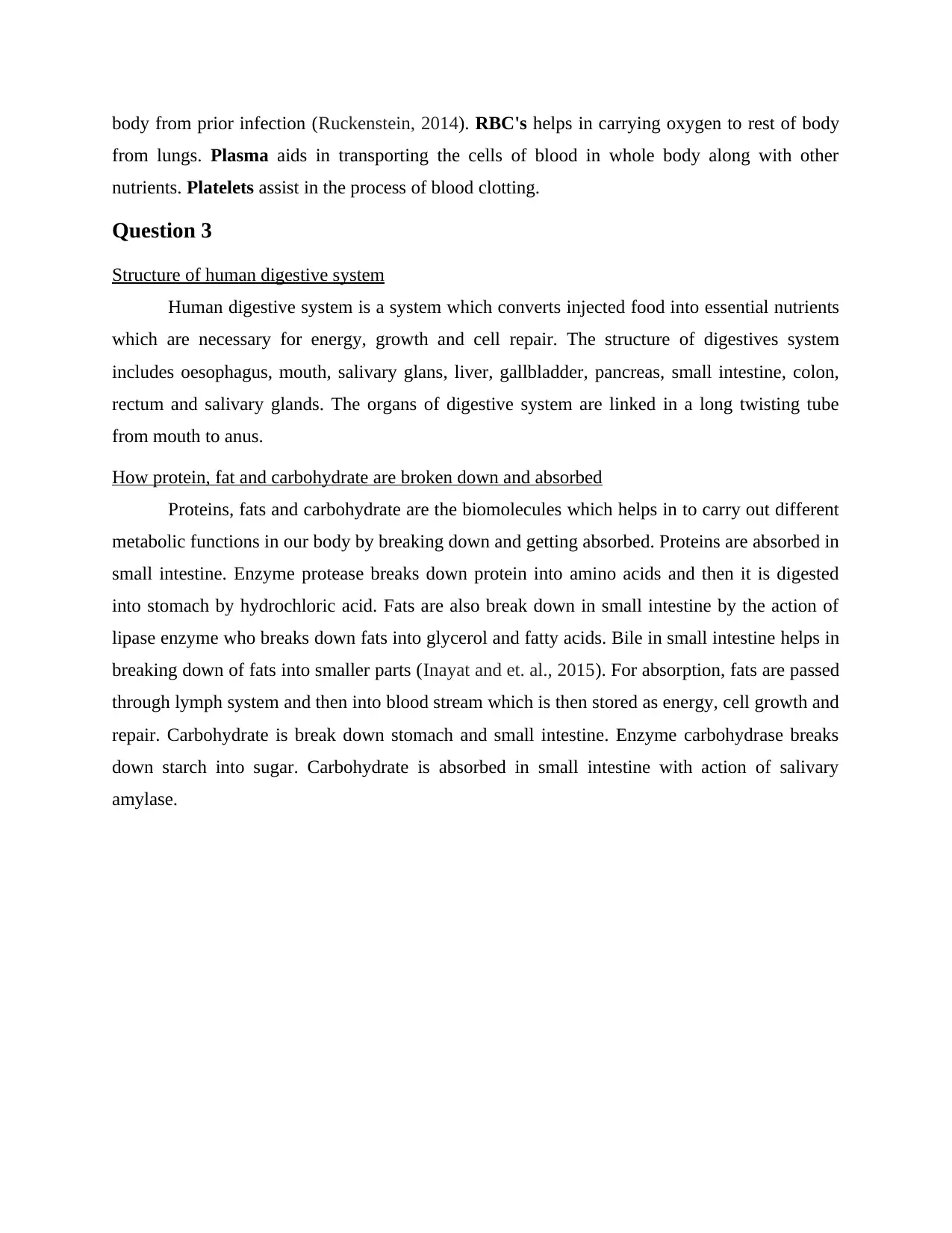
body from prior infection (Ruckenstein, 2014). RBC's helps in carrying oxygen to rest of body
from lungs. Plasma aids in transporting the cells of blood in whole body along with other
nutrients. Platelets assist in the process of blood clotting.
Question 3
Structure of human digestive system
Human digestive system is a system which converts injected food into essential nutrients
which are necessary for energy, growth and cell repair. The structure of digestives system
includes oesophagus, mouth, salivary glans, liver, gallbladder, pancreas, small intestine, colon,
rectum and salivary glands. The organs of digestive system are linked in a long twisting tube
from mouth to anus.
How protein, fat and carbohydrate are broken down and absorbed
Proteins, fats and carbohydrate are the biomolecules which helps in to carry out different
metabolic functions in our body by breaking down and getting absorbed. Proteins are absorbed in
small intestine. Enzyme protease breaks down protein into amino acids and then it is digested
into stomach by hydrochloric acid. Fats are also break down in small intestine by the action of
lipase enzyme who breaks down fats into glycerol and fatty acids. Bile in small intestine helps in
breaking down of fats into smaller parts (Inayat and et. al., 2015). For absorption, fats are passed
through lymph system and then into blood stream which is then stored as energy, cell growth and
repair. Carbohydrate is break down stomach and small intestine. Enzyme carbohydrase breaks
down starch into sugar. Carbohydrate is absorbed in small intestine with action of salivary
amylase.
from lungs. Plasma aids in transporting the cells of blood in whole body along with other
nutrients. Platelets assist in the process of blood clotting.
Question 3
Structure of human digestive system
Human digestive system is a system which converts injected food into essential nutrients
which are necessary for energy, growth and cell repair. The structure of digestives system
includes oesophagus, mouth, salivary glans, liver, gallbladder, pancreas, small intestine, colon,
rectum and salivary glands. The organs of digestive system are linked in a long twisting tube
from mouth to anus.
How protein, fat and carbohydrate are broken down and absorbed
Proteins, fats and carbohydrate are the biomolecules which helps in to carry out different
metabolic functions in our body by breaking down and getting absorbed. Proteins are absorbed in
small intestine. Enzyme protease breaks down protein into amino acids and then it is digested
into stomach by hydrochloric acid. Fats are also break down in small intestine by the action of
lipase enzyme who breaks down fats into glycerol and fatty acids. Bile in small intestine helps in
breaking down of fats into smaller parts (Inayat and et. al., 2015). For absorption, fats are passed
through lymph system and then into blood stream which is then stored as energy, cell growth and
repair. Carbohydrate is break down stomach and small intestine. Enzyme carbohydrase breaks
down starch into sugar. Carbohydrate is absorbed in small intestine with action of salivary
amylase.
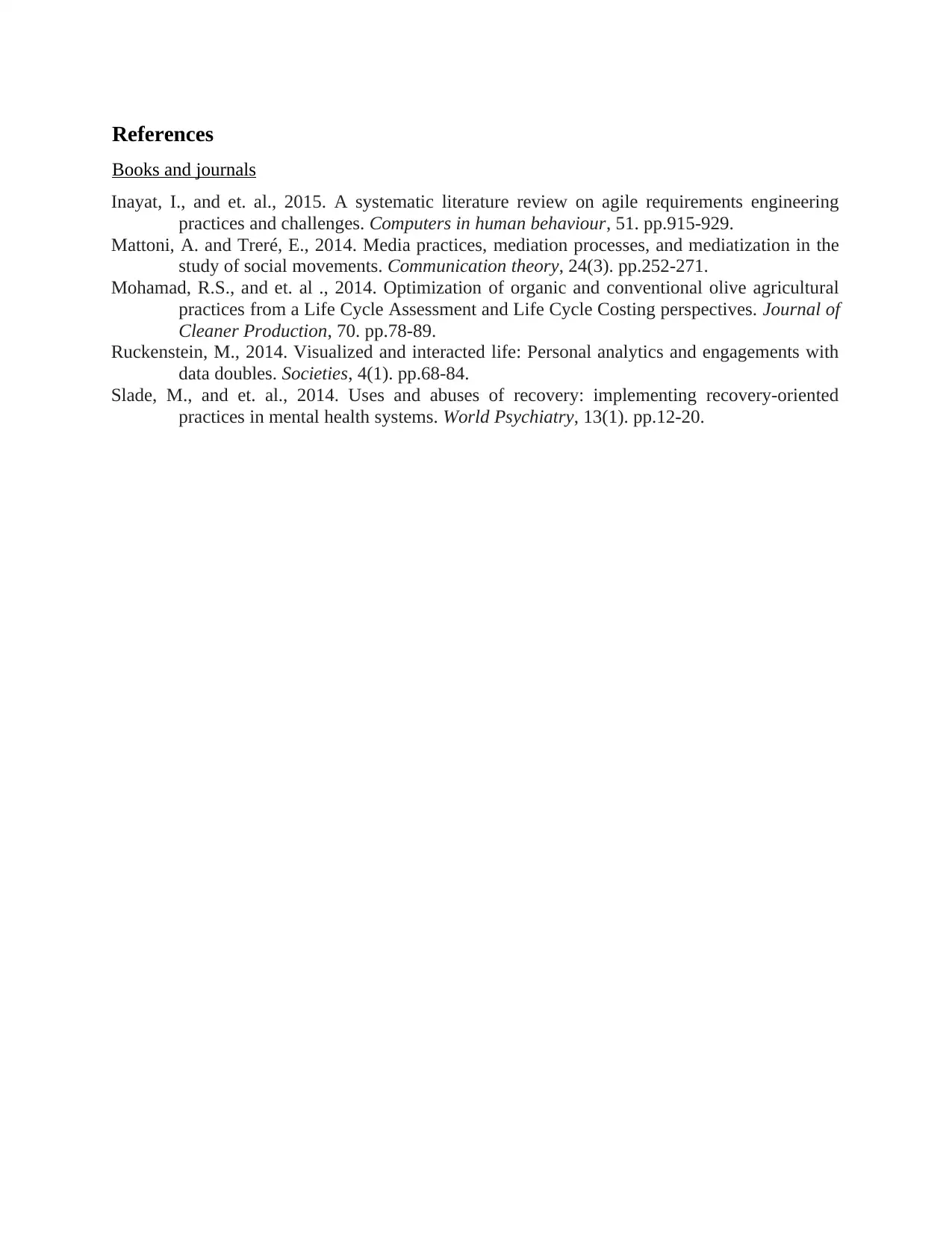
References
Books and journals
Inayat, I., and et. al., 2015. A systematic literature review on agile requirements engineering
practices and challenges. Computers in human behaviour, 51. pp.915-929.
Mattoni, A. and Treré, E., 2014. Media practices, mediation processes, and mediatization in the
study of social movements. Communication theory, 24(3). pp.252-271.
Mohamad, R.S., and et. al ., 2014. Optimization of organic and conventional olive agricultural
practices from a Life Cycle Assessment and Life Cycle Costing perspectives. Journal of
Cleaner Production, 70. pp.78-89.
Ruckenstein, M., 2014. Visualized and interacted life: Personal analytics and engagements with
data doubles. Societies, 4(1). pp.68-84.
Slade, M., and et. al., 2014. Uses and abuses of recovery: implementing recovery‐oriented
practices in mental health systems. World Psychiatry, 13(1). pp.12-20.
Books and journals
Inayat, I., and et. al., 2015. A systematic literature review on agile requirements engineering
practices and challenges. Computers in human behaviour, 51. pp.915-929.
Mattoni, A. and Treré, E., 2014. Media practices, mediation processes, and mediatization in the
study of social movements. Communication theory, 24(3). pp.252-271.
Mohamad, R.S., and et. al ., 2014. Optimization of organic and conventional olive agricultural
practices from a Life Cycle Assessment and Life Cycle Costing perspectives. Journal of
Cleaner Production, 70. pp.78-89.
Ruckenstein, M., 2014. Visualized and interacted life: Personal analytics and engagements with
data doubles. Societies, 4(1). pp.68-84.
Slade, M., and et. al., 2014. Uses and abuses of recovery: implementing recovery‐oriented
practices in mental health systems. World Psychiatry, 13(1). pp.12-20.
⊘ This is a preview!⊘
Do you want full access?
Subscribe today to unlock all pages.

Trusted by 1+ million students worldwide
1 out of 6
Related Documents
Your All-in-One AI-Powered Toolkit for Academic Success.
+13062052269
info@desklib.com
Available 24*7 on WhatsApp / Email
![[object Object]](/_next/static/media/star-bottom.7253800d.svg)
Unlock your academic potential
Copyright © 2020–2025 A2Z Services. All Rights Reserved. Developed and managed by ZUCOL.





